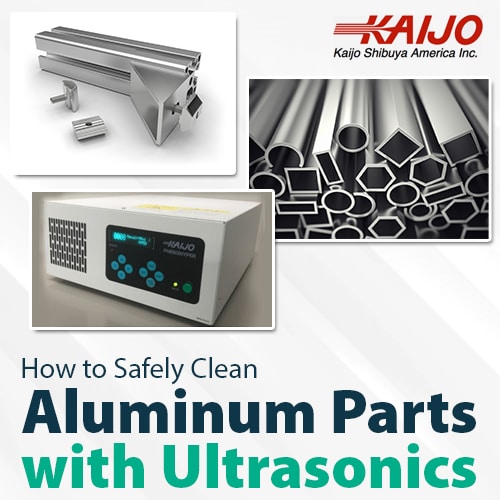How to Safely Clean Aluminum Parts with Ultrasonics
October 6, 2022
 While low ultrasonic frequencies are commonly used to clean metal surfaces, they can’t be used with aluminum parts. Aluminum is a relatively soft metal, and using low ultrasonic frequencies can result in surface pitting and damage to aluminum parts. Although using higher frequencies may mean the cleaning process is slower, additional measures can help speed up the cleaning of aluminum parts, at the higher ultrasonic frequencies.
While low ultrasonic frequencies are commonly used to clean metal surfaces, they can’t be used with aluminum parts. Aluminum is a relatively soft metal, and using low ultrasonic frequencies can result in surface pitting and damage to aluminum parts. Although using higher frequencies may mean the cleaning process is slower, additional measures can help speed up the cleaning of aluminum parts, at the higher ultrasonic frequencies.
How Cleaning Performance Depends on the Ultrasonic Frequency
Ultrasonic cleaning works by generating microscopic cavitation bubbles in the cleaning solution. When the bubbles burst, they produce a powerful jet that removes contaminants from part surfaces—the lower the ultrasonic frequency, the larger the bubbles. Bubble size is related to the cleaning intensity, and larger bubbles produce more powerful jets. When these high-energy jets hit soft surfaces, they can cause damage. Instead of removing contaminants, they can create pits on the surface of soft materials such as aluminum or damage delicate structures.
When higher frequencies are used for soft materials, the smaller bubbles produce weaker jets, reducing the cleaning intensity. This means cleaning times are increased for heavily contaminated parts because it takes longer to remove all the contaminants. Parts with soft surfaces and light contamination can be cleaned quickly, even at the higher ultrasonic frequencies. An experienced manufacturer of industrial ultrasonic cleaners can recommend suitable systems for the cleaning of all types of aluminum parts.
How to Choose the Right Frequency for Aluminum Part Cleaning
In many standard ultrasonic cleaning systems, 40 kHz is a common frequency for cleaning a variety of metal parts. This frequency is too low for aluminum parts, and such cleaning systems may result in damage to aluminum surfaces. The minimum frequency that should be used with aluminum parts is 78 kHz. Depending on the surface contamination, frequencies up to 430 kHz are effective at removing surface dirt from aluminum parts.
For heavy contaminants such as oil and grease, a 78 kHz industrial ultrasonic cleaner will clean aluminum parts quickly and safely. For lighter contamination, such as fine surface particles, frequencies up to 430 kHz are appropriate. If a part has two or more types of contamination, a multi-frequency ultrasonic cleaning system may be the best choice. This is also true when aluminum parts and parts made from metals with hard surfaces need to be cleaned. Hard metals can be cleaned at frequencies as low as 26 kHz, while aluminum parts must be cleaned at frequencies at or above 78 kHz.
How to Speed Up Cleaning at Higher Frequencies
When using frequencies of 78 kHz or higher to clean aluminum parts, the cleaning action of the smaller cavitation bubbles is less intense, cleaning performance is reduced, and cleaning can take longer. To compensate, the cleaning solution can be heated, and a mild detergent can be added. The heat softens oily and greasy contamination, while the detergent acts as a surfactant to help dislodge contaminants.
While other acidic or basic cleaning agents are often added to ultrasonic cleaning baths to speed up cleaning, aluminum is highly reactive and will combine with many other common cleaners. A heated bath will speed up such reactions. Instead, only a neutral detergent should be used with aluminum.
Kaijo’s Experts Provide Guidance in Selecting the Right Ultrasonic System
As a leading ultrasonic cleaner manufacturer, Kaijo has extensive experience with all types of ultrasonic cleaning, including cleaning aluminum parts. Kaijo’s experts help customers choose the right system and frequency and make recommendations regarding the system’s power, heating temperature, and configuration. In addition, Kaijo can supply equipment from a complete line of ultrasonic cleaners and offers support for many different kinds of ultrasonic cleaning applications. Contact Kaijo for a free consultation to discuss your specific cleaning application and challenges.





